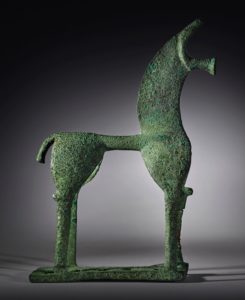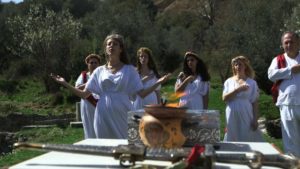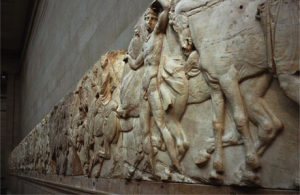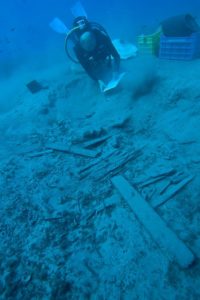An interesting, legal appeal involving disputed Greek artefacts has been taking place in the courts of New York state.

8th century BC bronze horse Sculpture owned by the descendants of art collectors Howard and Saretta Barnet
First of all, it is worth looking at the image of the bronze horse sculpture (that is the subject of the case).
It dates from the 8th century BC, but with it’s abstracted elegant form would not look out of place in a contemporary art exhibition.
This is a case where one could easily argue that the art has a value of it’s own purely on an aesthetic basis, separate from what any provenance might prove or dis-prove about it’s origins.
But this gets onto the basis of the story – there is very little provenance.
Our first record of the existence of the sculpture is in the catalogue of the May 6, 1967 Münzen und Medaillen auction in Switzerland.
Before that point we know nothing.
The current owners are the descendants of art collectors Howard and Saretta Barnet. They acquired the piece in 1973 from art dealer Robin Symes who “very probably” acquired it from the 1967 auction.
In the 1970s, Robin Symes was seen as a respected antiquities dealer – however, he has since been unmasked as a key player in an international criminal network that traded in looted archaeological treasures. Now, to the best of my knowledge there is no evidence that he was involved in any wrongdoing in this particular case – however, there is no evidence to the contrary either, other than the 1967 catalogue which gives a start to the item’s provenance.
On May 14th 2018, Sothebys in New York was due to host “The Shape of Beauty: Sculpture from the Collection of Howard and Saretta Barnet” auction, which included this item as one of the lots. Meanwhile, Christos Tsirogiannis, an antiquities expert who scours auction catalogues noted this proposed sale and, sent a letter to a criminal intelligence officer at Interpol’s works of art unit stating that:
“Please find attached the three images of a bronze Greek figure of a horse, of the Corinthian type, from the confiscated Symes-Michaelides archive. The same figure is to be auctioned as lot 4 in New York, by Sotheby’s at their 15/4/2018 auction.” After citing the provenance given in Sotheby’s catalogue, he writes “Please notify the American judicial authorities in New York, as well as the Italian and Greek police authorities as it is of paramount importance to examine ‘Münzen and Medaillen AG’ in Basel in order to be discovered the identity of the consignor of this bronze horse back in 1967, a valuable information which will eventually lead to the country where the object was discovered.”
Subsequently, the day before the auction was due to take place, Greece’s Ministry of Culture sent the auction house a letter saying the the bronze horse sculpture was the property of Greece and therefore should be returned to Greece immediately. Sotheby’s withdrew this lot and proceeded with the rest of the auction.
As you may have guessed though, this is far from the end of the story. On June 5th 2018, A lawsuit was filed jointly by the Barnet heirs and Sotheby’s in the US District Court for the Southern District of New York. The lawsuit asserted that Greece had interfered in the sale “without lawful justification.”
They sought a Declaratory Judgement that the bronze horse sculpture was “acquired lawfully and in good faith by the late Howard Barnet 45 years ago and has been part of their collection ever since.” They also sought a further ruling the Greece has no ownership rights and that they are permitted to continue with the sale of the work.
The basis of the lawsuit is the assertion by Sotheby’s that there is no factual basis to assert that the Bronze horse belongs to Greece. Once could easily counter this though with the fact that there is also no clear evidence that the sculpture was excavated and removed from Greece legally.
There is a good writeup of the case up to this stage here.
Now, as you might imagine, there are many interested parties keen to block cases such as this, which could potentially disrupt sales of any artefacts where the provenance is unclear. A letter to the Antiquities Trade Gazette by Joanna van der Lande, chairman of the Antiquities Dealers Association, stated that: “long-term damage is being inflicted on both the trade and museums” by the growing number of legal cases surrounding antiquities with long North American provenances.
Moving forward to today, last Friday (21st June), U.S. District Judge Katherine Polk Failla rejected Greece’s claim to dismiss the lawsuit. Greece made the claim under the Foreign Sovereign Immunities Act, a 1976 US law that establishes the limitations as to whether a foreign sovereign nation (or its agencies) may be sued in U.S. courts.
The reason for the dismissal is under the section of the act that exempts commercial activity, which provides three bases under which a plaintiff can sue a foreign state.
- When the plaintiff’s claim is based upon a commercial activity carried on in the United States by the foreign state.
- When the plaintiff’s claim is based upon an act by the foreign state which is performed in the United States in connection with commercial activity outside the United States.
- When the plaintiff’s claim is based upon an act by the foreign state which is performed outside the United States in connection with commercial activity outside the United States and which causes a direct effect in the United States
Greece argued that such a broad interpretation of this exclusion “would have a chilling effect on the ability of foreign sovereigns to protect their cultural heritage.”
The US courts argued that the Greek Government engaged in commercial activity by sending the letter to Sotheby’s to halt the sale. They also noted that “some U.S. courts have said acts taken to advance a sovereign country’s cultural mission could be deemed commercial in nature.”
You can read the coverage of this stage of the cases here. Full details of the case are available here.
Whether Greece will appeal against this decision or not is ass yet unclear.
The case highlights some of the issues of handling looted cultural property cases under the current legal frameworks – the onus is generally on the claimant to prove that the items were looted, rather than the current owners to prove that their provenance is sufficient. When many of the illegal excavations took place some years ago and were unrecorded, this is often very tricky to do. From what I have read on the case so far, it is unclear whether any further details of the 1967 sale (particularly the vendor and purchaser) have been revealed in the course of the last year.
While the Foreign Sovereignty Immunity Act has many flaws, we should also not see it as being against restitution cases as such. Only a few days earlier, the court of appeals for the District of Columbia dismissed a petition to re-hear a landmark ruling from that the heirs of the art dealers who sold the Guelph Treasure under duress during the Nazi era may pursue their claims in U.S. federal court. The meaning of this is that German state museum must face claims based on allegations of Nazi-looted art in their collections – the result of five years of denying the Guelph Treasure claimants any meaningful attention. How easy it is for a US court to enforce such a case in Germany is a separate question of course. There is a lot that could be learned from saga of Agudas Chasidei Chabad v. Russian Federation, et al. a few years ago, where state courts participating in international affairs almost led to a major diplomatic incident between the USA and Russia.










